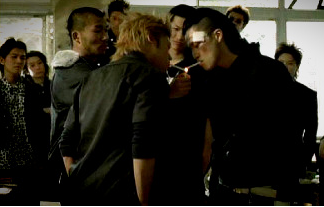Humanbeings are social animals.This means that human beings can’t live without interacting with other people. As people interacted with other people throughout human history, the term “friend” evolved. To me, a friend is someone who I can really trust.
As I watched the movie “Catfish,” I desperately began to think about “relationships” between people. The movie is about a woman, Angela who used a fake ID, Megan, to contact a man; Nev. Megan and Nev were interested in each other and had great time using Facebook, a place where it is possible to meet people without knowing them personally. Nev and Megan felt actual love and affection toward each other under the term “friends” on Facebook. A relationship without knowing the real identity of someone seems awkward, doesn’t it? On the Internet, we use the term “friend” to qualify someone we do not know. Like this, people tend to use the word “friend” more easily and lightly and lighter than before in modern society. This is why I thought about the meaning of “real friend” in our modern society after watching this movie.
Before the age of Facebook, people met other people and gradually developed their relationships personally. Because people had to meet in a same place to communicate; it actually made people more accurately to determine who to be closer to or not. If person “A” wanted to be closer with person “B”, A and B should meet frequently. As they meet each other, they get to know each other because they talk. They talk about social problems, friendships, private life, etc. By having conversations with these topics, both A and B get close enough to know each other beyond just typing. And friend A could also read the inner emotion of friend B, because people see the emotional changes. So, real friends can really understand feelings and minds off line.
But, in reality, it is hard to make or to find a real friend. This is because the atmosphere of modern society is “competition.” People mainly think about their own interests, and less about others. So, it is hard to find a friend who can really understand other people.
Not only the atmosphere, but society has changed into a place where people easily contact other people. For example, in a Facebook friend list, there are many people who I don’t know. We just push a button that says “friend” to ask to be “accepted.” Because, Facebook is the largest part of Internet society, there are no limitations with time or place to meet other people. This means that people can easily find a “friend” who isn’t able to meet in real world. This situation led people to stay in their home lowering interactions between people. As people have many friends in online, it decreases the preciousness of each real friend that we establish offline.
In the movie, Angela was so bored with her life that she wanted a man who can play and chat with her. She needed a “friend” who can make her life fresh. But Angela, not reliable but according to the movie, love Nev. This shows that on-line relationships are not limited to friendships, but also love. This shows another part of the problem; although, she was married, she felt love with another person that she doesn’t know. As people can be easily friend with other people, the relationships between people were weakened. This led people to blind their eyes, which made the people hard to find and satisfied with real friends.
What made Angela’s life so bored and barred. Because I don’t have lots of information with Angela’s life; it’s hard to answer, but I believe that Facebook can be an answer to this question. According to “Catfish,” she didn’t go outside very much, because she was busy on doing her domestic works. Instead of going outside, she tends to use Facebook to make friends. As she continued this life pattern, she had no offline friends.
This movie, Catfish, makes us to think about relationships between people that are established by social network system. Due to social network system, the meaning of friends was diluted. Not only the meaning, but it made people insensitive to real friends. Catfish is a great example that shows these changes on relationships.










